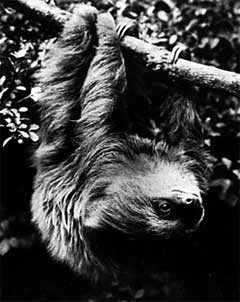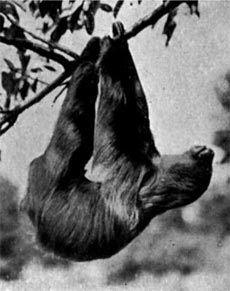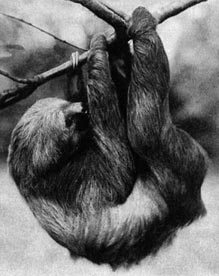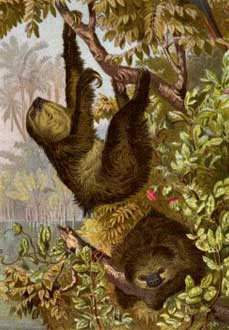|

 Just the Facts: Sloth fur also exhibits specialized functions: the outer hairs grow in the opposite direction to that of other mammals, i.e. pointing away from their extremities (so as to provide protection from the elements despite living legs-uppermost), and in moist conditions host two species of symbiotic cyanobacteria, which may provide camouflage. Just the Facts: Sloth fur also exhibits specialized functions: the outer hairs grow in the opposite direction to that of other mammals, i.e. pointing away from their extremities (so as to provide protection from the elements despite living legs-uppermost), and in moist conditions host two species of symbiotic cyanobacteria, which may provide camouflage.
Their outer fur coat is usually a thick brown, but occasionally wild sloths appear to have a green tinge to their fur because of the presence of these bacteria. The bacteria provide nutrients to the sloth, and are licked. Sloths have short, flat heads, big eyes, a short snout, long legs, and tiny ears.
Watch Out for the Claw: Their claws also serve as their only natural defense. A cornered sloth may swipe at its attackers in an effort to scare them away or wound them. Despite sloths' apparent defenselessness, predators do not pose special problems: in the trees sloths have good camouflage and, moving only slowly, do not attract attention. Only during their infrequent visits to ground level do they become vulnerable.
Sloth Hunters: The main predators of sloths are the jaguar, the harpy eagle, and humans. The majority of sloth deaths in Costa Rica are from sloths getting into electrical lines and from poachers. Despite their adaptation to living in trees, sloths make competent swimmers. Their claws also provide a further unexpected defense from human hunters - when hanging upside-down in a tree they are held in place by the claws themselves and do not fall down even if shot from below, thus making them not worth shooting in the first place.

Amazing Adaptations: Sloths have made extraordinary adaptations to an arboreal browsing lifestyle. Leaves, their main food source, provide very little energy or nutrition and do not digest easily: sloths have very large, specialized, slow-acting stomachs with multiple compartments in which symbiotic bacteria break down the tough leaves. Sloths may also eat insects and small lizards and carrion.
Strange Stomach: As much as two-thirds of a well-fed sloth's body-weight consists of the contents of its stomach, and the digestive process can take as long as a month or more to complete.
 Even so, leaves provide little energy, and sloths deal with this by a range of economy measures: they have very low metabolic rates (less than half of that expected for a creature of their size), and maintain high body temperatures when active (40 to 44 degrees Celsius), and still lower temperatures when resting. Even so, leaves provide little energy, and sloths deal with this by a range of economy measures: they have very low metabolic rates (less than half of that expected for a creature of their size), and maintain high body temperatures when active (40 to 44 degrees Celsius), and still lower temperatures when resting.
Half the Muscle, Half the Speed: Sloths move only when necessary and then very slowly: they have about half as much muscle tissue as other animals of similar weight.
They can move at a marginally higher speed if they are in immediate danger from a predator, but they burn large amounts of energy doing so. Their specialized hands and feet have long, curved claws to allow them to hang upside-down from branches without effort. While they sometimes sit on top of branches, they usually eat, sleep, and even give birth hanging from limbs.
Lots of Leafy Greens: Sloths are omnivores, and generally eat leaves, especially those of the cecropia tree. Fruit flies are in their diet as well. Sloths have a very low metabolism and a low body temperature so their food and water needs are minimal.
A sloth's stomach has many different compartments to help digest the tough plants they eat.
 In terms of their sleep, sloths are one of the most somnolent animals ever, sleeping from 15 to 18 hours each day. They are particularly partial to nesting in the crowns of palm trees where they can camouflage as a coconut. They come to the ground, to urinate and defecate, only about once In terms of their sleep, sloths are one of the most somnolent animals ever, sleeping from 15 to 18 hours each day. They are particularly partial to nesting in the crowns of palm trees where they can camouflage as a coconut. They come to the ground, to urinate and defecate, only about once
a week.
Successful Sloths: Although unable to survive outside the tropical rainforests of South and Central America, within that environment sloths are outstandingly successful creatures: they can account for as much as half the total energy consumption and two-thirds of the total terrestrial mammalian biomass in
some areas.
Of the five species, only one, the Maned Three-toed Sloth, has a classification of "endangered" at present. The ongoing destruction of South America's forests, however, may soon prove a threat to the others.

 Built to Fall: Infant sloths normally cling to their mother's fur, but occasionally fall off. Sloths are very sturdily built and very few die from the fall. In some cases they die from the fall indirectly because the mothers sometimes prove unwilling to leave the safety of the trees to retrieve them. Females normally bear one baby every year, but sometimes sloths' lack of movement actually keep females from finding males for longer than Built to Fall: Infant sloths normally cling to their mother's fur, but occasionally fall off. Sloths are very sturdily built and very few die from the fall. In some cases they die from the fall indirectly because the mothers sometimes prove unwilling to leave the safety of the trees to retrieve them. Females normally bear one baby every year, but sometimes sloths' lack of movement actually keep females from finding males for longer than
one year.
All in the Family: The living sloths belong to one of two families, known as the two-toed (Bradypodidae) and three-toed sloths (Megalonychidae). Both families have three toes: the "two-toed" sloths, however, have only two fingers. Two-toed sloths are generally faster moving than three-toed sloths.
Both types tend to occupy the same forests: in most areas, a particular single species of three-toed sloth and a single species of the larger two-toed type will jointly predominate.
All text is available under the terms
of the GNU Free Documentation License
|